More than one hundred migration stories were collected by the Upper Dales Family History Group in 2010, to be published as Those who left the Dales [website link still to come]. This essay is an extended version of one of them.
Although I have written much about Swaledale, I have not yet published many stories about my family. Here is one of them. For Swaledalers, it is packed with familiar names and familiar places, plus a Westmoreland WINTER or two.
George and Ann METCALFE
One of the many Dales METCALFE families in the early 1800s was that of George and his wife Ann (HARKER) of Ivelet Heads in Swaledale. Their eldest daughter Jane, baptised in 1808 when George and Ann were living at Heights - about a mile east of Gunnerside - was my great-great-grandmother.

Of George and Ann's eight children, two moved early to Stainmore farms. They and their growing children (those underlined below) quickly took over South Stainmore and are described more fully later on in this story, to which I have now added a bit more about my great-great-grandfather James SPENCELEY and his family. The eight were:
- Jane 1808-1892 (married James SPENCELEY 1838 Coverham); children: Ann (1840-1845), William Mason (b 1843), Ann (b 1845; first wife of Isaac WINTER), George (b 1850) all born at Coverham. James' first marriage to Mary FALSHAW (d 1830) produced Margaret (b 1830) - her unhappy story as Margaret BARKER is on Christine Amsden's website. James' second wife was Elizabeth GRAHAM of Askrigg (d 1836) and their daughter was Rosamond (b 1835) who married Francis FALSHAW in 1857. Rosamond is buried with her mother in Coverham churchyard.
- Thomas 1811-1848 - married Mary PRATT in 1835; children: Margaret Ann (1837), George (1839, m Isabella BLACKETT and farmed at nearby Nateby), Rosamond (1841-45), Thomas (1845).
- Robert 1813-1868 - did not marry. He was a schoolmaster and lived in Calvert Houses with his widowed sister Elizabeth.
- Elizabeth (Betty) 1814-1888 - before her marriage to miner/farmer Thomas DUNN in 1849 (no more children) she had a son John (b 1840) - relatives now say his father was a William SPENSLEY but nobody has any proof. Betty's later life is expanded in Ann Buxton's letter. John METCALFE married Annie BELL and though they settled at Low Gingerfield farm just outside Richmond, one of their sons - Ernest Robert (b 1879) emigrated to New Zealand where his grandson Ted is another offshore member of the Upper Dales group.
- Rosamund (Rosey) 1817-1879 - married Calvert Houses farmer John COATES 1841. The family moved to Stainmore early on and their ten children were Christopher (1842), Ann (1845), Elizabeth (1847), Mary Jane (1849 - m Gunnerside postmaster's son Wm SUNTER 1874Q4; they moved to West Derby as cowkeepers), George (1851), John (1853 - m Priscilla HOLLIDAY 1889Q4; then to farm at Dufton, Cumberland), Robert (1855 - to Dufton farm with brother John), Rose (1858-77), Margaret (1860 - m John NICHOLSON 1886Q1, to Brough, then Liverpool), Agnes (1864 - m John DOWTHWAITE of Dufton; then lived in Brough).
- George 1819-1887 - married his brother's widow Mary in 1849; children: Rosamond (1850 - m Brough farmer John BECKWITH; farmed at High Ewbank then New Hall on Stainmore, just off the map), Mary Jane (1854 - m Bowes farmer John ALLISON; later to Marrick), James Robert (1857).
- Margaret (Peggy) 1824-1863 - married lead miner John FAWCETT at Muker in 1852, both of Ivelet Heads; children: John (1854), Ann (1855), George Metcalfe (1861). Peggy died in 1863 and John took himself and their children to Wisconsin in 1865.
- Mary Ann 1821-? - a straw hat maker in 1851, she married lead miner (but later landowner and farmer) William BUXTON in 1844; their children were all born at Gunnerside: Hannah (1845 - m Muker lead miner Edward SUNTER 1867Q2; eventually to West Derby as cowkeepers), Ann (1849 - second wife of Isaac WINTER), George (1851), and William (1854).
Enter James SPENCELEY, and his many siblings
In 1838 Jane married James SPENCELEY, a twice-widowed gamekeeper born at Feetham Holme, son of James and Rosamond SPENCELEY [nee MASON]. The wedding took place in Coverham, not Swaledale. I don't know why. Jane's father had died but her mother and younger siblings were all still around at Ivelet Heads in 1841 but her brother George at least made the journey, because he gave her away. There were a couple of SPENSLEYs in Coverham: Raw and his sister Mary - children of James of Harkerside. Each married in Coverham around the same time, but I have not yet found a link between these two lines. More importantly, neither has Christine Amsden, yet, and I regard her as the guardian of all things related to the Dales Spensleys. James and Jane spent much of their married lives at Widdymans in Coverdale, where James was gamekeeper for Sir William Chaytor. I have already written about their Oleander breakfast set elsewhere and shall write separately about his life and his many appearances in court, prosecuting poachers on behalf of his employer, and about the other children. Because as well as James' two daughters from his previous marriages, James and Jane had four other children: a little Ann who died as a child (Christine Amsden's website has the coroner's report of her death) William Mason who became a policeman, Ann who married Isaac WINTER, and George who went quickly into service (more below).
There is much more to tell, of course, and Christine Amsden has many SPENSLEY stories on her website, including that of miner Anthony and William (sons of Ralph of Barfside) who emigrated to Dubuque in 1839. Anthony's wife Ann [WHITEHEAD, m Grinton July 1831] went too, with their toddler Sarah. And Ron Spensley, Chair of the Barnsley FHS, in his chapter of that FHS's own publication called Moving Lives describes and details the lives of two groups of Swaledale Spensleys who moved to the coalmines of Barnsley. Both groups were from Feetham Holme, which now looks like this and, with Ron's kind permission, I can now add a bit about the migration to Barnsley.
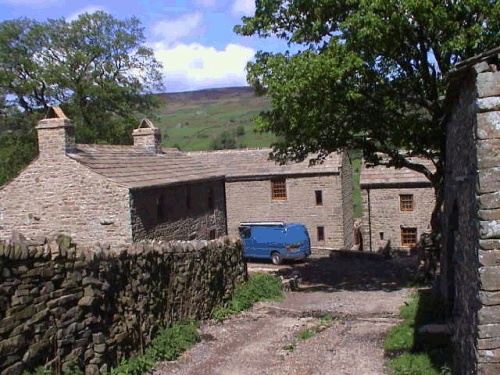
Those windows look new to me, but the lintel of one of the doors is carved with the date 1699. The first family - whose connection to 'my' Spenceleys is still unclear - was George, born about 1772, with his wife Margaret [HARKER, m at Grinton in Oct 1804], three sons, two daughters, and a mother-in-law, who all moved to Crane Moor Nook near the Silkstone colliery; George died in 1833. The second family was that of my James's four siblings and his widowed father James (1773-1846), all of whom later emigrated to Dubuque, Iowa. The siblings were: Richard (1805-92, who married Alice BONSON), Mason (1814-44); Margaret (1821-?) and William (1824-?). They were probably persuaded to move to Barnsley first by yet another brother - Thomas - who had already moved there and started the branch of the family tree that now includes Ron Spensley.
Lead-mining in Swaledale had slumped in the early 1800s so it would not be difficult to persuade some of the Swaledale miners to move away to guaranteed work. There were a few mine-owners in Co Durham and south Yorkshire who had connections with the upper Dales.
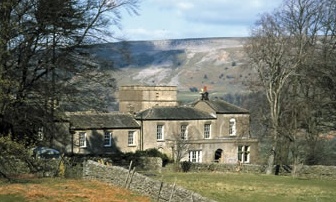
Ron knows of mine-owners Lord Wharncliffe, who had an estate at Simonstone Hall, Wensleydale, as well as his home base at Wortley, near Barnsley, and Frederick Vernon-Wentworth, who was busy developing his mines near Barnsley and building housing for his miners. I recently found out that another mine-owner, James FENTON of Doncaster, bought Grinton Manor estate and built a shooting lodge up on the moor above the village in 1817, and very close to all those Spensleys at Feetham Holme. If you are a member of the YHA you can stay there yourself now, which is probably more than any of the Swaledale folk managed to do.
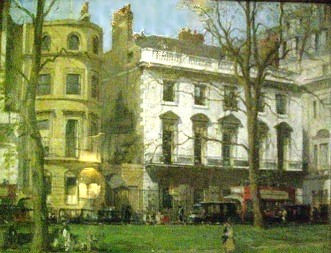
During my wider research into this period, I have realised that not only did ordinary families correspond regularly when they were separated, and help each other out, but also that landowners and rich patrons, or their agents, also passed good workers on to each other, and looked out for possible new staff when they were visiting each others estates. One good example is of James and Jane's youngest son George. As boys, George and his brother must have helped out their gamekeeper father during the regular shoots and hunts. Yet by 1871 this lad was in service as a footman at Weston Hall near Otley, and by 1881 he was valet to Lord Rosebery who had just married the richest woman in England and who was given this Rothschild house on Piccadilly as a wedding present.
Hannah Rothschild was a close friend of the wife of the Earl de Grey, who was a close friend of the Prince of Wales, and by 1891 George was butler in the de Grey's London home in Bruton Street the heart of Mayfair, very handy for Fortnum and Mason. The de Grey country estate was at Studeley Royal near Harrogate, where George lived when he retired to breed racehorses. Such a meteoric rise and soft landing can only have happened because he was noticed, poached, valued, and handed on!
Back to the story. Maybe the earlier migration of his brothers explains the otherwise brief and unexpected foray south to the Barnsley coalmines by James and Jane just before 1871. Why they went is a mystery. They had been settled in Coverdale for decades, their children were settling into their own lives. James' employer Sir William Chaytor - another man with coalmining interests in Co Durham - was still alive (though he died in February 1871). Their son William Mason had married in the Barnsley district in 1867 - had he gone first? Did the family move together? If they had moved away before 1868 then that might explain why Ann married on Stainmore, rather than in Coverdale. Whatever the reason, James and Jane appear in the Dodworth census for 1871, living in Alma Street - you can see this street yourself on Google's Street View; what an innovation! James, now aged 70, was described a coal leader, which Ron says is a carter. Poor chap; what a comedown after all those years out on the moors. These days you would expect anyone who had been a gamekeeper for forty years to have had enough put by to retire. But it is possible that his Caldberg cottage had come with the job. No job, no home, no income, no pension. In the same year there was some kind of family gathering at Dodworth - the consequence of a crisis? - during which time three of their grandchildren were born, on what must have been flying visits to a very small terraced cottage. The new babies were: James Spenceley WINTER (my grandfather), his cousin Sarah SPENCELEY (daughter of William Mason SPENCELEY), and also possibly James FALSHAW (whose claim to be born in Barnsley is in just one of the censuses); even Rosamond's husband Francis FALSHAW maybe died there. For whatever reason, everyone turned up. If anyone knows more about why I would love to know!
Post script: In July 2010 I received an email from Mary Bullough, the great-great-granddaughter of Francis FALSHAW, enclosing a copy of Francis' death certificate. She had been told about this METCALFE story on my website and has very kindly agreed that I can add her new information.
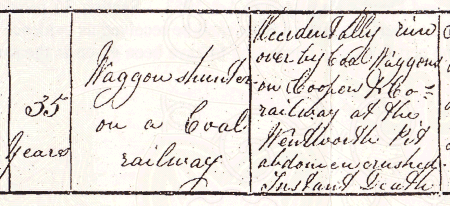
The whole certificate is huge so here is a cutting of the crucial part. The death was registered by the coroner of the Honor of Pontefract after an inquest held on the 2nd September 1867. The certificate says that Francis, a waggon shunter, had been accidentally run over by Coal Waggons on the Cooper & Co railway at the Wentworth Pit at the Old Silkstone Colliery on the 31st August. "Abdomen crushed. Instant Death". He was 35 years old.
Because Francis died at work there is no record on the certificate of his home address, or of any other family member. And I suspect that the inquest made sure that Rosamond was not entitled to any compensation by declaring the death an accident. My source for this assumption is When the Boat Came In - a wonderful BBC television series from the 1980s where Jack Ford, as a Geordie shop steward in the 1920s, had to fight against such decisions. I do not think that Trades Unions existed in the 1860s but certainly by Jack's time a cause of negligence would have made the colliery owners liable. I didn't have far to go to check - a few years ago my husband John wrote about Will Thorne and the Leeds gas strike that followed his efforts in 1889 to start the National Union of Gas Workers, the first successful trades union, so it looks as if the Barnsley coalfield men were not protected by law in the 1860s. Rosamond and her children were in danger of being sent to the workhouse, if she could not support the family herself. Is this why she returned to Caldbergh - her home parish? She might not have had any choice. I can see another story starting so I had better stop now. Mary, great-granddaughter of Francis' son Robert, has published her own family tree online (here is a link) and now asks if anyone knows more about Cooper & Co, or about the Wentworth Pit? If you can help, or if you have any early photographs of Robert and his family, then please email her at marybullough(at)gmail.com.
The WINTERs at Calva House
Isaac WINTER married Ann SPENCELEY early in 1868, at Brough. Ann was already in service in Stainmore (more below) so maybe James and Jane had already left Coverham; I don't know. For whatever reason, Ann did not marry from her parents' house and the wedding was on Stainmore.
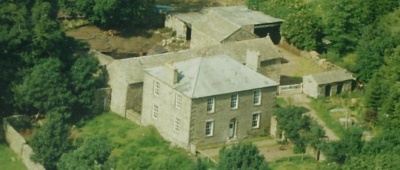
In 1871 Isaac was working for the railway company whilst his father William WINTER was running the dairy farm with his three adult daughters and a farmhand. Isaac and Ann lived at Calva with their baby son John Wilson and almost certainly lent a hand too. At the time of the 1871 census, Ann was pregnant again and for some reason later that year went to visit her parents in Barnsley, along with her brother William and her half-sister Rosamond, as I have already described, where James Spenceley WINTER was born. Some time later Ann's parents finally retired and came to live at Calva. Ann's father James, the ex-gamekeeper, died first in 1875; Isaac's mother Mary Ann (nee WILSON) in 1879Q3. By 1881 Calva was full of young children and the remaining grandparents. The house itself is an imposing two-storey Georgian square building, although the present owners tell me that that was added sometime in the early 1800s as a completely new frontage to an earlier farmhouse that had faced the other way! There were outbuildings and a spare cottage or two, so there would have been plenty of room.
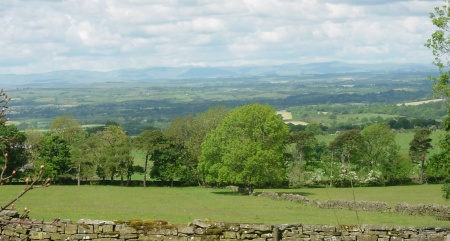
Jane's view of the Lake District hills from Calva House's living room window - did she call it "the parlour"? - is now the background photograph on my monitor, 200 miles due south.
Then Ann died. I wonder if her mother Jane organised a support network? Whoever was responsible, in 1884 Isaac married Ann's cousin Ann BUXTON, another dutiful daughter who had moved with her father and brothers from Gunnerside up onto Stainmore to farm. Ann BUXTON was Jane SPENCELEY's niece, daughter of Mary Ann and William BUXTON of Ivelet Heads. Here is an extract from a 20thC letter sent by one of Isaac's grandchildren to his own grandson, writing about Isaac and the second Ann:
"He was a man of strong religious principles and a founder member of Mouthlock Methodist Chapel, South Stainmore. He gave generously to the building fund of this chapel and there is a stone with his name inscribed on it built into the walls.
"Beside his herd of milk cows (your Great Great Grandma used to make Westmoreland Cheese from the milk) he had a flock of sheep which used to run on the fell sides during the summer and as this was open land other farmers used to do the same so each farmer had his own registered mark so that when the sheep were brought down to the lower grounds in the autumn they could tell their own by the trade mark. Your Great Great Grandad's was a small piece cut out of the top of the left ear and a W for Winter burnt into the left horn. This was done in the Spring time whilst they were lambs before they were taken up to the fells for summer.
"Your Great Great Grandma was a farmer's daughter before she became your G G Grandads wife." [so the writer is clearly writing about the second Ann]
.This new Ann took on Isaac's seven young children and his first mother-in-law (her aunt), organised the household and her share of the farmwork, and got a good reputation for her cheesemaking. She and Isaac did not have any more children but it was she who had to deal with the early deaths of three of her step-children. It must have been heart-breaking.
The move to Otterburn
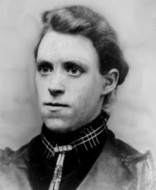
Jane SPENCELEY finally died in 1892, at the age of 84. Isaac and his second Ann took the children and moved south a bit to a farm at Otterburn Hall near Gargrave. And it was there, when accompanying her Bradford milk dealer father up into the dales to look for additional milk supplies to be delivered ("on the morning train", according to the letter I quoted earlier) that the young widow Hannah Davies met James Spenceley WINTER. Hannah, widowed in 1896 with two very young daughters, helped her dad with his Wakefield Road milk round before becoming a weaver. Maybe her dad thought she would enjoy a trip up into the Dales ... James and Hannah married in 1898 at Prospect Methodist Chapel, East Bowling, Bradford, but one of Hannah's two little daughters died shortly after the wedding. The death of small children was much more common then but I am certain that the grief was just as awful. The other daughter survived, unmarried, until just before I was born and I have her signet ring in my dressing-table drawer.
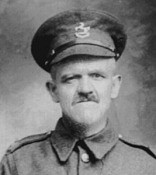
On the National Archives records for WW1 I found a 7-page medical discharge record dated 24 October 1918 for James Spenceley WINTER, aged 46.
His regiment is given as the 27th Kings Liverpool Regiment (the family had moved to New Brighton for my grandmother Hannah's health). James volunteered in June 1918 but was quickly found to have bad eyesight and on 5th July started the series of medical examinations which resulted in his discharge as "permanently unfit".
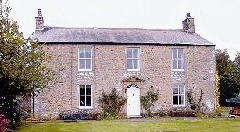
In 2005, when we drove up to have a look around, Otterburn Hall was for sale! A quick dash into Skipton showed that it was well outside our price range, but there was a brief moment when it was ours, in our heads at least. George BUXTON, an old UDFHG member, told me that George COATES (from Palliard), James Robert METCALFE (from Skirry Gill) and Isaac WINTER had all moved to the Otterburn district about the same time. I have a copy of Isaac's will, where he names GC and JRM as his executors. And George's copy of the young William BUXTON's cowbook lists JRM as a customer. These three men were of an age, and two of them were cousins of the wife of the third. The reliance on family which manifests itself so strongly in most of these 19thC stories is alien to many of my own generation born 100 years later, where the opportunities to live and work away were taken from choice rather than necessity.
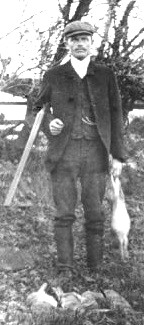
Isaac and three of his unmarried children - Rosamond, Isaac and Wilson - are buried together in the nearby Kirkby Malham churchyard. As well as James Spenceley, Isaac and Ann's surviving children were:
- John Francis (1875-1916), an unwilling schoolboy, truanting young poacher, and keen ornithologist (see photograph) whose experimental incubators eventually enabled him to send healthy pure-bred chicks by rail around the country from his Craven Poultry Farm at Bell Busk. He died suddenly, aged just 42 and his funeral and obituary were reported in detail in the local newspaper.
- Mary Jane (1873-?) who married farmer Charles RICKARDS of Bell Busk;
- Annie (1876-?) who married Joseph WHITELL in Clitheroe, 1912, (the nephew of Nancy who married George Metcalfe of Palliot) and, says my cousin John, whose son Christopher moved from Scarborough to Wellington, New Zealand, after WW2.
Stainmore 1860s-1900s
Young Ann SPENCELEY might well have been in service on Stainmore, at Borrenthwaite Hall, thanks to her aunt, who was well established at the neighbouring Palliott Farm. Rosamond COATES was one of the many Metcalfe sisters in this story which, like many, spreads across counties and continents. Borrenthwaite Hall is in the trees at the lower end of this valley; Palliott farm and the Stainmore railway line summit are just behind us on the right:
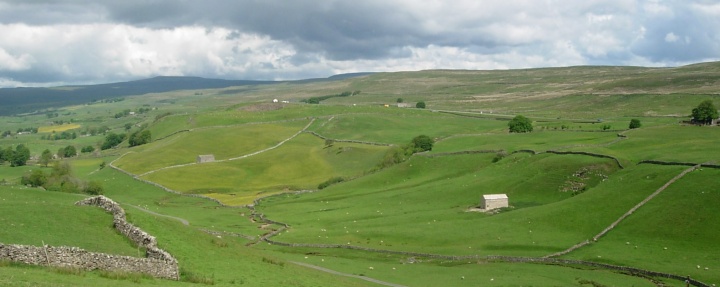
I have drawn a map of the Metcalfe homes on Stainmore and, since this story was originally written at the request of Glenys Marriott for the Upper Dales Family History Group's 10th Anniversary in 2010, I have extended it north by a mile or so and marked Cumpstone House at A at the very top, just to show you that Glenys's CUMPSTONs got everywhere too! Here is a link to the Brough section of her website if you want to find more of them. But I noticed quite early on that those of Jane's family who did not emigrate moved to be very close to each other, and my map illustrates their neighbourliness on Stainmore between about 1860 and the 1900s.
Calva House is B at the bottom of the map; the rest are numbered roughly clockwise from the top. Every one of the underlined farms and houses shown on this map contained members of this METCALFE family (apart from the odd WINTER). In the list below I have identified everyone by their relationship to Jane METCALFE or her son-in-law Isaac WINTER - the underlined people had started off in Swaledale. But even now the map is out of date. After I had sent it off to the editor of the Dales book I discovered that George and Mary METCALFE lived briefly at Rampson when they moved up from Ivelet Heads, so that ought to be underlined too. Even more of Jane's close relatives were living just off the map, as had my WINTER ancestors in Westmoreland, and I have listed them too.
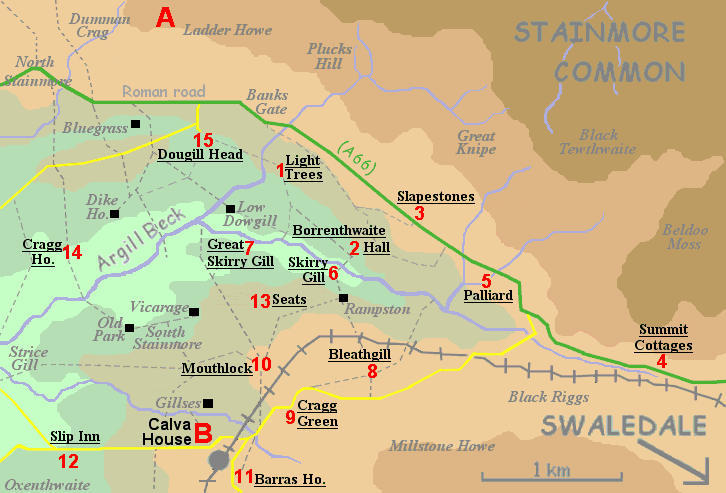
I redrew and simplified this map from an OS map of Stainmore published in 1925. The metalled road shown on modern maps as looping north from the Slip Inn round past the Vicarage, the Skirrygill farms and Rampson, to rejoin the marked road near the railway bridge, did not exist then but a modern OS map shows many footpaths (dotted lines) which must have been in daily use
1: Light Trees Margaret Ann [b 1837 Ivelet Heads, daughter of Jane's brother Thomas METCALFE and his wife Mary] and her husband Isaac TALLENTIRE lived here from 1866 to 1892, when Isaac died. By 1901 Margaret had moved to live with her brother George at Little Musgrave, just the other side of Brough. (She had vanished between 1871 and 1901 until I found her living with George. Christine Amsden helped me decipher her surname and I was then able to track back and find her marriage in the GRO index; it is mis-transcribed on freebmd!)
2: Borrenthwaite Hall (later Barrenthwaite) is where a 16-year-old Ann SPENSLEY was a housemaid in the 1861 census. I hope that she was really my great-grandmother-to-be Ann SPENCELEY, daughter of James and Jane, born at Widdymans in 1845 and niece of Jane's sister Rosamond COATES, long settled at Palliot farm, half a mile away. This Ann is the only one b Yorks of the right age in that census, and this is the only way in which she could have met Isaac WINTER of Calva House. Isaac's father was a farmer but in the early 1860s Isaac was working for the new railway company that had just built the line - including the infamous Belah Viaduct - and Barras station, just up the hill from Calva House. My story about the influx of railway workers on to Stainmore in 1861, and partial transcript of the local census, is on the Cumbria Railways website, including the stonemason and his labourer who were billetted at Calva House, along with the railway company's clerk. Isaac and Ann married in 1868, so here I am.
3: Slapestones Home of farmer William COATES [b 1870 Stainmore, grandson of Jane's sister Rosamond] and his wife Ada from about 1895 to 1901+.
4: Summit Cottages Close to the railway summit, this is where Ann [b 1845, daughter of Jane's sister Rosamond] and her husband John BOUSFIELD live from 1865. In the 1871 and 1881 censuses John was a platelayer and Methodist lay preacher. By 1891 the family had moved to West Derby, where John was a cowkeeper with premises at 21 and 23 Albert Street. After John died, Ann and her children ran a green-grocery in Toxteth Park, Liverpool.
5: Palliard Called Palliott in the early censuses, this was the farm of Jane's sister Rosamond [Rosey, b 1817 Calvert Houses] and her husband John COATES [b 1811 Calvert Houses, son of miner Christopher and Betty]. I can't find them in the 1851 census but their son Christopher was baptised at Gunnerside Wesleyan chapel in April 1842 and their next daughter, Ann, is not in that register and she was born in 1845. Palliard had probably become vacant in the early 1840s (see No 10 Mouthlock). Certainly the COATESes were at Palliard at the 1861 census. Rosamond and John died within months of each other, in 1880, and were buried at Brough with their young daughter Rose, who had been just 20 when she died in 1877. The 1881 census shows that seven of their children were still running the farm, with Mary Jane (32) the eldest and George (30) calling himself Head of Household. Some time after 1891 Mary Jane married John ALLISON, a farm labourer, and they moved first to Bowes and then back to a farm on Schoolmaster Pasture, up above Marrick. George married Nancy [WHITELL, b 1851 at High Oxnop, Swaledale, aunt of the Joseph who later married Annie WINTER] and they moved to Orton - across near the modern M6, and possibly just visible from Jane's parlour window.
6 and 7: Skirry Gill and Great Skirry Gill The censuses don't make clear who lived where, but one of these farms was home to Jane's brother George METCALFE [b 1818 Calvert Houses] and his wife Mary from about 1858 to 1887 - this wife Mary [PRATT] needed some sorting out, because she was first married to George's older brother Thomas [b 1806, died 1848, Ivelet Heads] and had sons with both of them.
Postscript: After I had finished the map, and this list, I read in Rosamond BECKWITH's obituary that she had been "... born at Ivelet Heads and moved to Rampson about 1860, at the age of nine". So her parents George and his new wife Mary did not move straight up onto Stainmore after their marriage, and one of the few greyed out farm names on the map really should be black and underlined as well, like this: Rampson!
Certainly Thomas and Mary's son Thomas [b 1845 Ivelet Heads] was at Skirry Gill in 1891. And one of the farms was occupied by James Robert METCALFE and his wife Elizabeth [HARRISON b Dufton] from about 1883 to 1900. James Robert was the son [b 1857 Stainmore] of George and Mary, and also Ann BUXTON's young cousin; he followed her into Otterburn Hall when she and Isaac moved to the nearby Kendal House around 1900.
8: Bleathgill This was the farm that Ann BUXTON wrote about to her cousin Ann FAWCETT out in Iowa. Ann's widowed father William BUXTON [who had married Jane's sister Mary Ann b 1821 Ivelet] took the farm and moved there from Ivelet Heads with Ann and her two brothers William and George some time around 1881. Ann married Isaac WINTER of Calva House in 1883, after the death of his first wife, her cousin Ann [SPENCELEY].
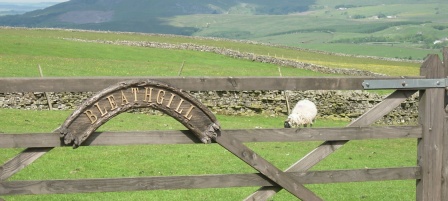
Ann's father William died soon after their move up on to Stainmore, and was buried back at Gunnerside's Wesleyan chapel. Her brother William moved on to farm in Ravenstonedale (and his cow book, now safely kept by his grandson George, gives a detailed and now very useful record of his customers) and then to Barrel Sykes at Kettlewell; Ann's brother George married Margaret METCALFE in 1890 [dau of John METCALFE of Muker cattle dealer] and moved to farm at Sedbergh - although by one of those quirks of the census we know that a matching Margaret was an in-patient at West Leeds District General Infirmary on the night of 5th April 1891; a long way to have to travel.

9: Cragg Green was the first local home of Isaac WINTER's sister Annie [b 1847 Stainmore] and her husband James HALL in 1881, when James was also a railway company employee. William WINTER, father of Isaac and Ann, lived with Ann and James until he died there in 1885.
10: Mouthlock is where Mary [daughter of Isaac's sister Annie HALL] and her husband Robert CLEASBY, cattle dealer, lived in 1901. In search of a Brough memorial inscription for James and Jane SPENCELEY, I found that the CLEASBY family had been one of the big families on Stainmore during the previous century: Anthony had died at Craghouse in January 1771, aged 52; Annas at Old Park in February 1878, aged 75, Elizabeth (1878 aged 80) and William Alderson CLEASBY (1881 aged 83) were still living at Grange Hall after the Metcalfe influx. But Robert had died at Palliard in August 1840 aged 80 - I wonder if John and Rosamond COATES took over the farm straight away?
11: Barras House was the home of Richard BRUNSKILL [b 1832 Stainmore] and his two sisters. Richard married Isaac's sister Jane WINTER in 1874, when Jane was 44. Jane had spent much of her adult life visiting and caring for her mother's sister, the unmarried and wealthy Jane WILSON, and may well have inherited her house in Ormside, although that is just me speculating. Jane died in 1889 and by 1891 Richard was a carter, living with his farming sisters at Slip Inn. By 1901 Richard's two farming sisters were dead and he had moved to live with another married sister in Brough, where he described himself as a medicine vendor. Clearly the man was incapable of cooking for himself or doing his own laundry.
12: Slip Inn By 1901, this was the third local home for Isaac's sister Annie and her husband James HALL, still a railway signalman. I have presumed it was a hamlet but there is little there now.
13: Seats Possibly the home of the younger Thomas METCALFE between 1881 and 1891 [see Ann's letter], and certainly the second local home of Annie and James HALL in 1891, when James was a signalman and farmer.
14: Cragg House home of farmer Christopher COATES [b 1842 Calvert Houses, son of Jane's sister Rosamond] and his wife Margaret from 1869. They had moved to Dufton (Appleby) by 1881.
15: Dougill Head Home of Elizabeth [COATES] (b 1847 Stainmore, daughter of Jane's sister Rosamond) and her husband Joseph NICHOLSON, where Joseph farmed, initially with his father, from 1868 until after 1901.
I suspect that very few of these farmers owned their farms. Maybe the COATESes at Palliott did, because they were there a long time, but experience of other families suggests that they rented their farms and houses; very few people owned their own homes in those days. And Ann FAWCETT's letter to Ann suggests that the BUXTONs were certainly renting.
Just off the map were:
- Jane's niece Margaret [COATES, b Stainmore 1860] and her husband John Robert NICHOLSON at Brough Sowerby. They lived there from 1886-1894. In the 1901 census the family was living at 75 Sutton Street, West Derby; John Robert was a stable yard foreman for Liverpool Corporation, and their son John (then 13) was a Port Insurance office boy.
- Jane's niece Rosamond [dau of George, b Stainmore 1850] and her husband John BECKWITH first lived at High Ewbank from 1892 to 1901 and later at New Hall, just south of Barras and a bit nearer to the community and the chapel. Rosamond's work for the chapel was written of fullsomely in her obituary published in the chapel magazine.
- Jane's nephew George [son of Thomas, who started off at Skirry Gill] and his wife Isabella lived at Rakehead, Nateby, from about 1865 to 1878, then at Winton Field, between Brough and Kirkby Stephen (1878 to about 1886). After that they moved to Little Musgrave, west of Brough, where George's widowed sister Margaret TALLENTIRE joined them.
- Jane's niece Agnes [COATES, b Stainmore 1864] and her husband John DOWTHWAITE lived in Brough High Street from 1886 to about 1892, then moved west to Dufton.
- Jane's nephew Robert [COATES, b Stainmore 1855] who moved with his brother John to farm at Dufton (Cumberland) and later went to Liverpool to help with one of the family cowhouses, but I don't know which one and I can't find him easily in the 1911 census.
Ann BUXTON
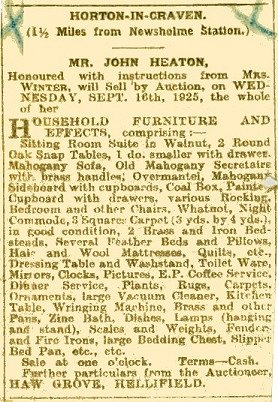
And a final bit of news about Ann (Buxton) WINTER. Ann died in Scarborough in 1927, aged 78. I wonder if she had gone to live with, or near, her step-daughter Annie WHITELL? Before Ann left Otterburn in 1925 she sold up all her household furniture. Here is a newspaper cutting, sent to me some time ago by her great-nephew George BUXTON, describing the furniture she sold at auction before she left.
The size of the carpets and amount of furniture suggest she was leaving a modest but well-equipped home (one online antiques glossary says a snap table has a top that snaps or folds down vertically over the supporting pillar). She must have had a separate sitting room, and at least three rooms that deserved carpets on the floor. There was a spare sofa, a spare bed and many spare mattresses and quilts - for visiting grand-children, maybe? I like the idea of a large vacuum cleaner, and the electro-plated coffee service. The wringing machine and zinc bath seem to be included with the kitchen equipment.
Apart from the bath and the large vacuum cleaner, this list almost exactly describes the contents of the tiny terraced house in Leeds that John and I rented briefly, forty years later. That house had belonged to the owner's mother and still had her peg bag hanging behind the pantry door. But we had electricity, an indoor bathroom and a mahogany bedframe for the feather mattress.
Furniture was made to last in those days; one of the most awkward pieces of furniture in our house is the blanket chest made by her uncle for my mother's 21st in 1936. One day we will live in a house that is too small for it, but not just yet.)
Isaac's will had said that the furniture was to be distributed amongst his children after Ann died but they were all well settled into their own households by 1925. I wonder if they simply said,"Thanks, but it's a bit old-fashioned for our taste"!
Cowkeepers
It is also interesting to see the cowkeeper link manifesting itself in these Metcalfes, too. Of the descendents mentioned above,
- Ann COATES and her husband John BOUSFIELD were cowkeeping in West Derby by 1891, at 21 and 23 Albert Street. They must have left Stainmore before 1881 because their youngest, George E, was shown as being born in Lancashire.
- Also in West Derby were Hannah BUXTON (Ann's sister) and her husband Edward SUNTER, cowkeeping at 60 Sutherland Street. They then moved to 11 Flaxman Street but Edward died in 1883. In 1901 Hannah was still at Flaxman Street; daughter Mary Ann was a dressmaker and son George a marine engineer's apprentice.
- Hannah and Edward's daughter Isabel and her husband Alexander KILBURN (also from Swaledale) had a cowkeeper business at Smithdown Road, Toxteth Park, but then moved briefly to Burnley, where their daughter Annie was born in about 1891. By 1901 they had a farm at Denholme Gate, up on the moors above Keighley in the West Riding. It can't be a coincidence that my grandfather James Spenceley WINTER was at Denholme Gate too describing himself, very mysteriously, as a refreshment house keeper. (By August of 1901 James and Hannah were at a small farm called Glen House near Denholme, because my uncle says he was born there. Anyone with access to Google Maps will see that it is a substantial old house.) I am beginning to suspect that Ann BUXTON (James' step-mother), like her aunt Jane SPENCELEY, was very good at managing people and events!
- Mary Jane COATES and her husband William SUNTER had moved to West Derby before 1881, but only just, because their youngest was born in Gunnerside in 1880. But Mary Jane died there and was buried in Brough churchyard, with her parents. William SUNTER (the Gunnerside postmaster's son) took their daughters across the country to Bishop Wearmouth, where he married again. He became a music and book dealer and his new wife Isabel, a bread and pastry maker, had a confectioner's shop. Two of the daughters started to learn the art of confectionery and one worked with her father in the music shop. I should think the evenings in their house were very pleasant.
Acknowledgements
This story started off as a Metcalfe tale for the Upper Dales Family History Group, with grateful thanks for their generous help and funny stories over the years, especially to Christine Amsden, who introduced me to the Group and who has been so generous with her information and time. The photographs of James, John Francis and Hannah came from my cousin John Clark WINTER; the Otterburn and Stainmore photographs were taken by me. The funeral cards and the auction sale cutting are from the collection of the UDFHG's own George BUXTON, who has kindly given me permission to reproduce them here. He also agreed I could include the transcripts of an 1880 letter from Ann BUXTON in Gunnerside to her cousin Ann FAWCETT in Iowa, and the reply, which you can read if you click here. Ted Metcalfe - who sent me the transcript of John Francis Winter's obituary, and the Mouthlock Methodist information - lives in New Zealand and knows a lot about Robert Ernest METCALFE and his wife Alice MYERS of Sandhutton, Thirsk. If you want to contact Ted directly his email address (which I have distorted deliberately to confuse spammers) is tmetcalfe(at)xtra.co.nz and he will be happy to correspond.
Please note that all of the YoBs here are inferred from baptism registers, or calculated from censuses. I have no certificates; I used the censuses to locate families and relationships. Also I realise that a family tree of all these cousins would be useful but it would not fit on one page. I do have an Excel file, with tree, of all the related WINTERs, METCALFEs and SPENCELEYs (and some of their SUNTER and BECKWITH and FALSHAW descendants) and where they all were in each census from 1841 to 1901, so if you want to follow any of this up, or correct any mistakes or misapprehensions, please email me from the button here in the left-hand margin.
Westmorland's genealogists have been thorough and generous with their research, and there is a lot of information online. The county link on Genuki is a good place to start, although I can tell you that a quick scan through the list of Monumental Brasses did not mention any illustrious Metcalfes or Winters, although there are a lot of WILSONs that might be worth checking out - it became a regularly used baptism name in the WINTER family. And on Genuki you will find a link to the transcript of Brough church's memorial inscriptions which, although it does not include James and Jane SPENCELEY, does have John and Rosamond COATES. Many of the METCALFEs were Methodists - some professionally so; others were lay preachers. Isaac WINTER was very active in raising funds for the chapel on Stainmore and was written of with affection in the chapel's magazine, as was Rosamond BECKWITH. John Robert METCALFE's son became a Methodist preacher and no doubt further research into Methodist archives will reveal more, but I don't want to start that just yet!
Barnsley's coal mining history is well documented online, and you will find much if you search for Silkstone or Dodworth. Here is a link to Barnsley council's history page, to get you started. And here is the Barnsley Family History Society's home page. The story of the 1838 Silkstone Colliery disaster is also online.
